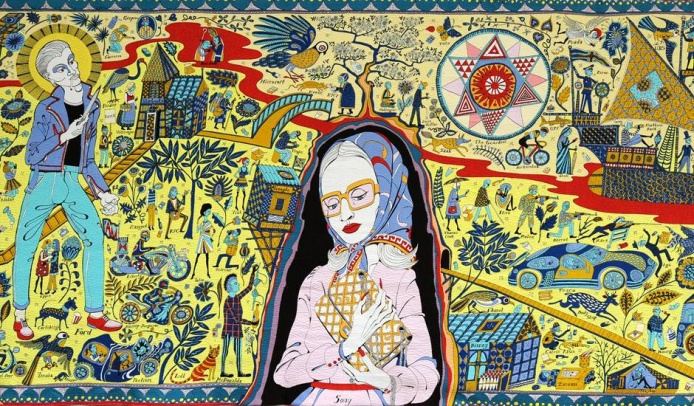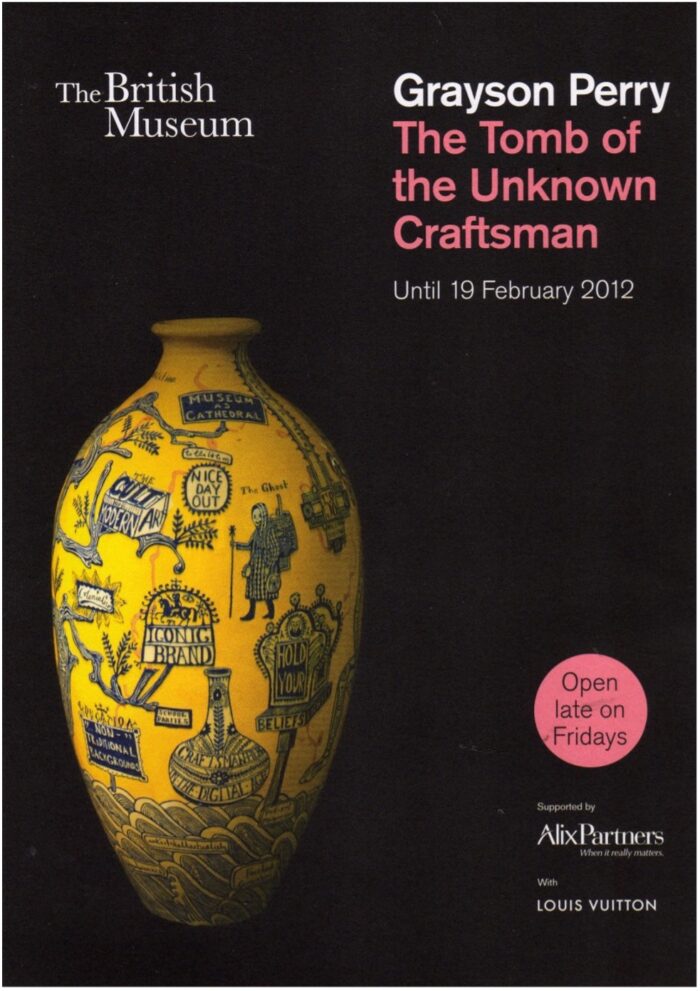- What We Do
- Understanding your audience
- Engaging new audiences
- Designing experiences
- Building loyalty
 Case studies
Case studiesBritish Museum: Grayson Perry - Culture Segments in action
For British Museum’s exhibition, Grayson Perry – The Tomb of the Unknown Craftsman, we used a combination of online research with their current market, and a review of Audience Atlas data on the market for charging exhibitions in London, to identify three primary and two secondary segments for targeting the exhibition at. The results were impressive, selling 186% more tickets than expected, and generating merchandise sales 500% above target.

The marketing challenge
Grayson Perry: The Tomb of the Unknown Craftsman was a charging temporary exhibition held at the British Museum, London from October 2011 to February 2012. Turner Prize-winning artist Grayson Perry curated an installation of his work alongside objects made by unknown men and women throughout history from the British Museum’s collection. In mounting the exhibition the British Museum sought to attract a new audience to the Museum, and to change perceptions of the British Museum as a place for contemporary artworks.
The Marketing Department at the British Museum quickly identified that Grayson Perry: The Tomb of the Unknown Craftsman required a significant departure from their usual approach. The British Museum recognised that the organisation’s traditional marketing strategies, successful as they are, were simply not going to work for the target audience.
A new approach to marketing was required if the exhibition was to meet its visitor targets.
The British Museum and Morris Hargreaves McIntyre worked together at an early stage of planning to carry out research to inform the development of the British Museum’s marketing campaign aimed at attracting a new audience for contemporary art to the Museum.
Using Culture Segments, an innovative sector-specific segmentation system for arts and culture organisations devised by Morris Hargreaves McIntyre in consultation with key sector organisations, including the British Museum, three target segments for the exhibition were identified. Formative research was carried out by Morris Hargreaves McIntyre to test the exhibition with each of the three target segments.
Using the findings, the British Museum developed and ran a differentiated campaign aimed at attracting visitors from the target segments.
The results surpassed all expectations.
Objectives
- Drive maximum exhibition ticket sales (target 60,000) and engagement with related events from audiences in London and the South East
- Drive secondary spend (membership, merchandise sales and catering opportunities)
- Entice visitors to visit the British Museum’s permanent galleries and collection online
- Position the British Museum as a venue for contemporary art and as an on-going source of inspiration
- Grow the British Museum’s social media profile
Researching the market
Morris Hargreaves McIntyre undertook analysis of their Audience Atlas UK dataset, a nationally representative survey of adults in the market for art, culture and leisure activities and events, to map the London temporary exhibitions market.
The exhibition proposition, themes, title, creative, ticket pricing and events were then tested through an online panel and focus groups using Culture Segments, the innovative segmentation system that Morris Hargreaves McIntyre and the British Museum had worked in collaboration to develop. Three primary segments were identified for the exhibition, each responding to different key messages.
This was followed by a cross-departmental workshop with Morris Hargreaves McIntyre and the British Museum to ensure that every element of the campaign was informed by the findings and targeted the segments.
Developing the campaign
Jessica Hunt, Marketing Manager at the British Museum summarises the approach the British Museum team took to developing and promoting the exhibition using the findings of the research – and the results that the campaign delivered.
The early-stage research showed that the main audiences for this exhibition were not primarily traditional ‘British Museum’ audiences. This meant that the campaign had to be creative to attract new audiences through new channels, positioning the British Museum in a different way than usual.
To achieve this, Grayson Perry was involved from the start of the marketing campaign. The British Museum consulted with him as both curator and artist, and this informed the overall marketing strategy.
The British Museum’s team used the research findings as the basis for the marketing strategy. The research also influenced the exhibition interpretation (panels, labels etc) and accompanying events programme.
A number of alternative lead images were tested with the target segments. The findings were used by the British Museum to develop the creative in collaboration with Grayson. Selecting Grayson’s bright yellow ‘Rosetta Vase’ (a reference to the iconic Rosetta Stone), along with pink, modern typeface – an unexpected colour contrast for a British Museum exhibition.
Grayson was also commissioned to design an exclusive free poster for marketing, which was printed as part of the fold out events programme, and featured in the exhibition as an object. The British Museum then worked with a specialist digital agency to create a digital marketing strategy.
Implementation
British Museum used Culture Segments to work with its marketing communications agencies, including Blue State Digital on the digital marketing strategy, Total Media on the media plan and Artshead and Impact on distribution.
Strategic partnerships with organisations that would help to reach new audiences were developed, including with Time Out, Frieze Arts Fair, the Crafts Council and University of the Arts London.
The British Museum carried out an ‘escalating’ campaign from April 2011 teasing interest and excitement with influencers using digital tools, building momentum to a high impact outdoors, press and digital advertising at the exhibition opening to support press and generate mass awareness. In the final weeks messaging was pushed through all channels to create a sense of urgency.
Impacts
The ticket sales target of 60,000 was exceeded after just 3 months, with final ticket sales of 112,194. Advance tickets sold out and the run of the exhibition was extended by a week to deal with the high level of demand. (Adult tickets to the exhibition were priced at £10).
All events reached capacity. The late event was especially popular, and a talk by Grayson had to be streamed live into another theatre due to 200% bookings.
Secondary spend through merchandise sales were 500% above target. In addition to successful take-up of the Grayson Perry afternoon tea (created with Marketing, Grayson and the catering team), the restaurant took over 800 bookings for the exhibition ticket and themed dinner package.
A membership event raised double the normal takings in the shops. A special offer of a free Grayson Perry-designed bag for new members and renewals was also very popular.
The campaign was been extremely successful in positioning the British Museum as a venue for contemporary art. For example, the marketing-led ‘stunt teddy bear’ competition was featured twice in the Evening Standard, including the announcement of the winners, in the Observer, The Independent and The Art Newspaper. Other press coverage reaching new audiences for the British Museum included Another Magazine, Dazed and Confused, Harper’s Bazaar, In Style, Grazia and Stylist. It was consistently listed top in Time Out, Guardian Guide, Spoonfed, Urban Junkies and Art Rabbit.
According to official British Museum visitor research conducted by Morris Hargreaves McIntyre with visitors to the British Museum (between October and December 2011), 35% of visitors were aware of the Grayson Perry exhibition before making their visit to the Museum that day. London-based visits increased from 16% to 24%, website views increased from 16% to 33%, and word of mouth increased from 19% to 28%, as compared with the same period the previous year.
The British Museum’s digital profile was also raised. During the campaign, Facebook ‘Likes’ increased by 85% and Twitter followers by 65%. Further Twitter activity included tweets by influencers such as Alexa Chung, Lauren Laverne and Mary Portas, and brands including Tate, Wallpaper and Louis Vuitton. For the first time, the British Museum used Foursquare, QR codes on print and exhibition panels linking to the video trailer, and ran behaviourally targeted digital advertising.
Most importantly, the exhibition captured the imagination of the public, with visitors inspired to view the collection in a new way. ‘This exhibition breathes new air into the British Museum. Seen in fresh context the British Museum exhibits come alive… Plus it’s fun. So refreshing to hear other visitors laughing and talking animatedly. Isn’t that what museums are for?’ – comment from the blog.
Evaluation
Research carried out by Morris Hargreaves McIntyre with visitors to Grayson Perry: The Tomb of the Unknown Craftsman identified that the three target segments of Essence, Expression and Stimulation were early adopters of the exhibition. Together these three segments made up 70% of the audience during the first half of the exhibition (October – December) – as compared with 34% of the UK cultural market as a whole.
In the second half of the exhibition’s run, the three target segments reduced in size to account for 42% of visitors, as three other, more risk averse segments (Affirmation, Enrichment and Release), adopted the proposition.
Using a phased approach to target early adopters with differentiated messaging via PR and digital channels generated a buzz around the exhibition, which worked to attract an innovative contemporary art audience to the British Museum. Having developed popular currency within the market, the offer was then taken up by a wider audience of individuals who are less willing to take risks with the new or unknown. Meaning that Grayson Perry: The Tomb of the Unknown Craftsman was able to attract a larger, paying audience than was originally anticipated.
- Engaging new audiences
- Understanding your audience
